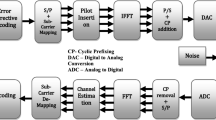Abstract
Integer wavelet transform (IWT) is an alternative to fast Fourier transform (FFT) in orthogonal frequency division multiplexing (OFDM) systems. It serves implementation flexibility and performance improvement by diminishing high side lobes, sensitivity to time and frequency synchronization. However, high PAPR of the transmitted signals is also a significant problem for IWT as in FFT based OFDM. One of the methods used for reducing the peak-to-average power ratio (PAPR) is partial transmit sequences (PTS) and this method requires an exhaustive search to obtain optimum reduction. This study examines the PAPR reduction potential of differential evolution algorithm based PTS scheme in lifting based wavelet packet modulation (LBWPM) system. The simulation results indicate that remarkable PAPR reduction performance with a low computational load for LBWPM system can be achieved using the proposed differential evolution based PTS scheme.








Similar content being viewed by others
Explore related subjects
Discover the latest articles and news from researchers in related subjects, suggested using machine learning.References
Bingham, J. A. C. (1990). Multicarrier modulation for data transmission: An idea whose time has come. IEEE Communications Magazine, 28(5), 5–14.
Han, S. H., & Lee, J. H. (2004). PAPR reduction of OFDM signals using a reduced complexity PTS technique. IEEE Signal Processing Letters, 11(11), 887–890.
Bisht, M., & Joshi, A. (2015). Various techniques to reduce PAPR in OFDM systems: A survey. International Journal of Signal Processing, Image Processing and Pattern Recognition, 8(11), 195–206.
Calderbank, R., Daubechies, I., Sweldens, W., & Yeo, B.-L. (1998). Wavelet transforms that map integers to integers. Applied and Computational Harmonic Analysis, 5(3), 332–369.
Huang, X. L., Wang, G., Chen, J., & Sun, Q. Q. (2012). A novel Haar wavelet-based BPSK OFDM system robust to spectral null channels and with reduced PAPR. Wireless Personal Communications, 67(3), 599–612.
Suma, M. N., Narasimhan, S. V., & Kanmani, B. (2014). Orthogonal frequency division multiplexing peak-to average power ratio reduction by best tree selection using coded discrete cosine harmonic wavelet packet transform. IET Communications, 8(11), 1875–1882.
Suma, M. N., Narasimhan, S. V., & Kanmani, B. (2015). A new OFDM system based on discrete cosine harmonic wavelet transform (DCHWT) for PSK and QAM. Wireless Personal Communications, 80(4), 1733–1746.
Taşpınar, N., & Tokur Bozkurt, Y. (2016). PAPR reduction using genetic algorithm in the lifting based wavelet packet modulation systems. Turkish Journal of Electrical Engineering and Computer Sciences, 24(1), 184–195.
Price, K., Storn, R., & Lampinen, Jouni A. (2005). Differential evolution: A practical approach to global optimization. Berlin : Springer.
Storn, R., & Price, K. (1997). Differential evolution—A simple and efficient heuristic for global optimization over continuous spaces. Journal of Global Optimization, 11(4), 341–359.
Ait Saadi, H., Guessoum, A., & Chouinard, J.-Y. (2011). Differential evolution algorithm for PAPR reduction in OFDM systems. In 7th International workshop on systems, signal processing and their applications (WOSSPA) (pp. 175–178). doi:10.1109/WOSSPA.2011.5931444.
Ghosh, S., Roy, S., Das, S., Abraham, A., & Islam, S. M. (2011). Peak to average power ratio in OFDM systems using an adaptive differential evolution algorithm. In IEEE congress on evolutionary computation (CEC) (pp. 1941–1949).
Yao, Y.-C., Hung, H.-L., & Wen, J.-H. (2011). PAPR reduction in OFDM system using differential evolution-based partial transmit sequences scheme. In International conference on machine learning and cybernetics (ICMLC) (pp. 1414–1419).
Hung, H.-L., & Huang, Y.-F. (2012). Peak-to- average power ratio reduction in orthogonal frequency division multiplexing system using differential evolution-based particle transmit sequences scheme. IET Communications, 6(11), 1483–1488.
Sweldens, W. (1998). The lifting scheme: A construction of second generation wavelets. SIAM Journal Mathematical Analysis, 29(2), 511–546. doi:10.1137/S0036141095289051.
Jansen, M., & Oonincx, P. (2005). Second generation wavelets and applications. London: Springer.
Jain, C., Chaudhary, V., Jain, K., & Karsoliya, S. (2011). Performance analysis of integer wavelet transform for image compression. In 3rd International conference on electronics computer technology (ICECT) (pp. 244–246).
Abd El-Hamed, M. A., Dessouky, M. I., Shawkil, F., Abd El-Samie, F. E., & Ibrahim, M. K. (2012). Integer wavelet transform for SC-FDMA system. In IEEE 8th international conference on informatics and systems (pp. 25–35).
Author information
Authors and Affiliations
Corresponding author
Rights and permissions
About this article
Cite this article
Tokur Bozkurt, Y., Taşpınar, N. Peak-to-Average Power Ratio Reduction in Lifting Based Wavelet Packet Modulation Systems Using Differential Evolution Algorithm. Wireless Pers Commun 94, 1073–1086 (2017). https://doi.org/10.1007/s11277-016-3670-5
Published:
Issue Date:
DOI: https://doi.org/10.1007/s11277-016-3670-5




